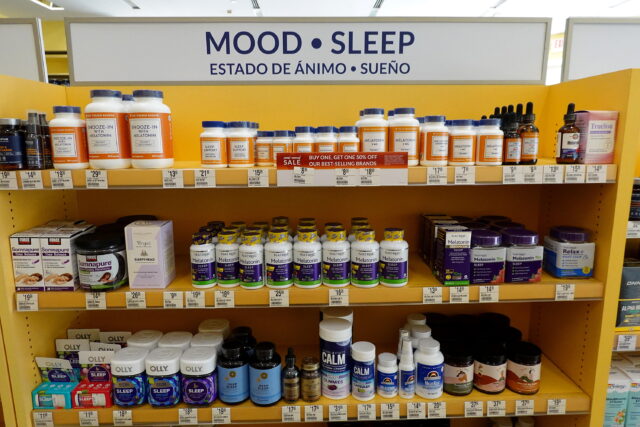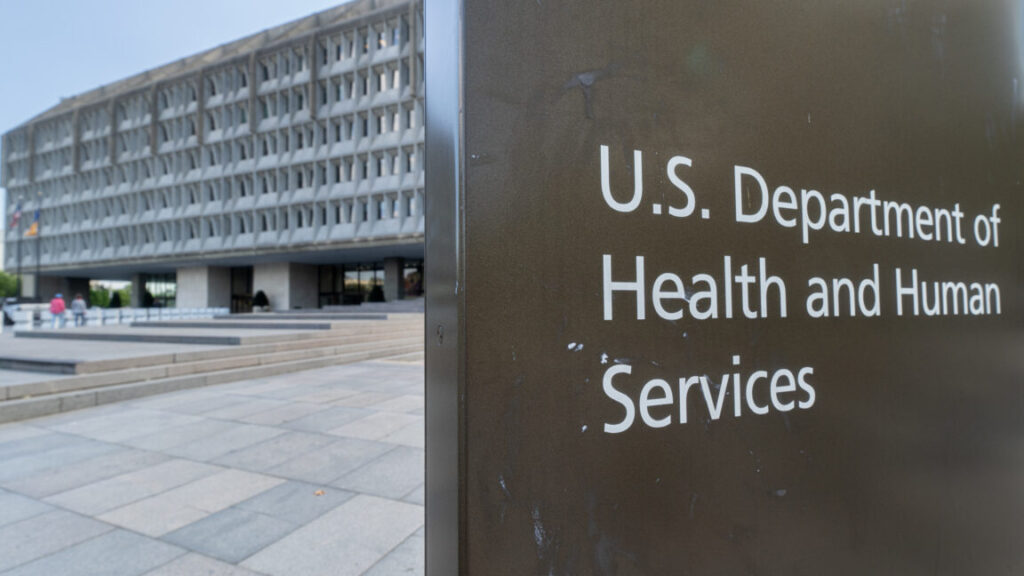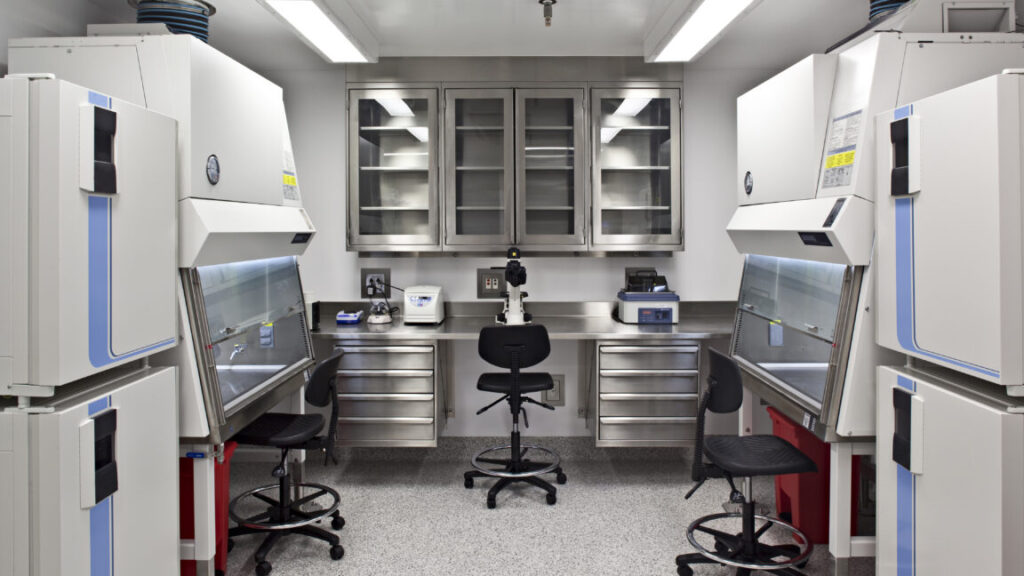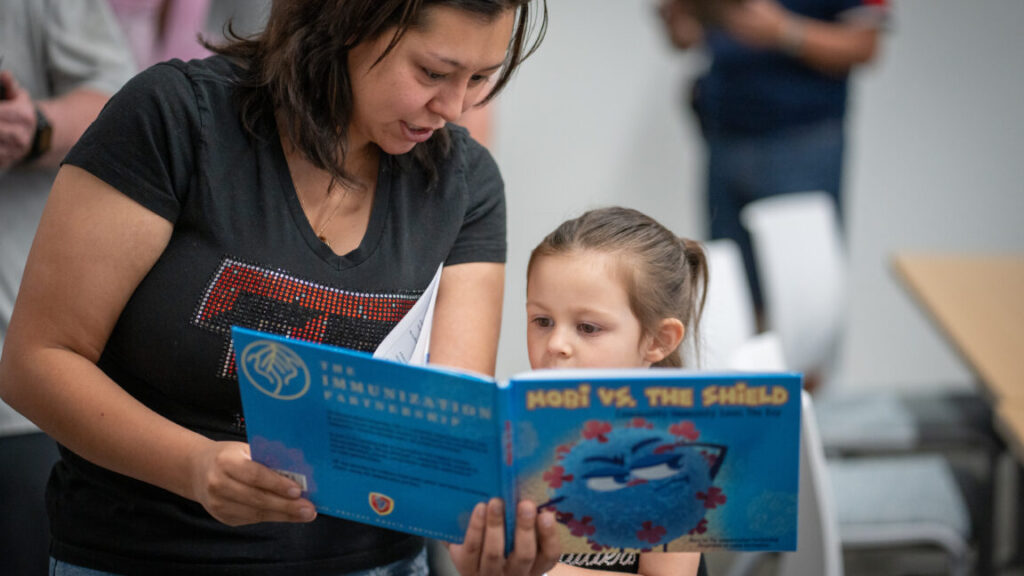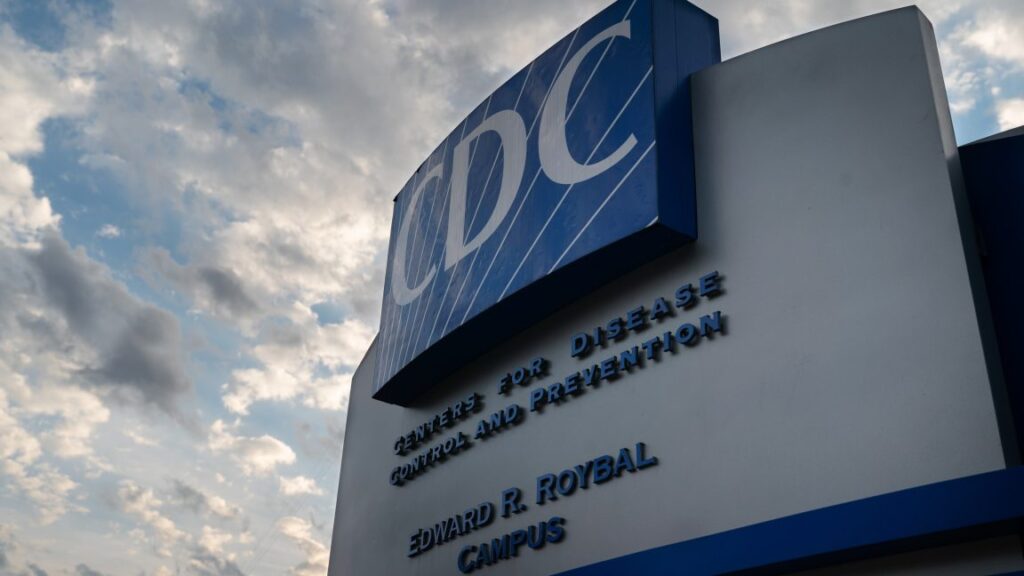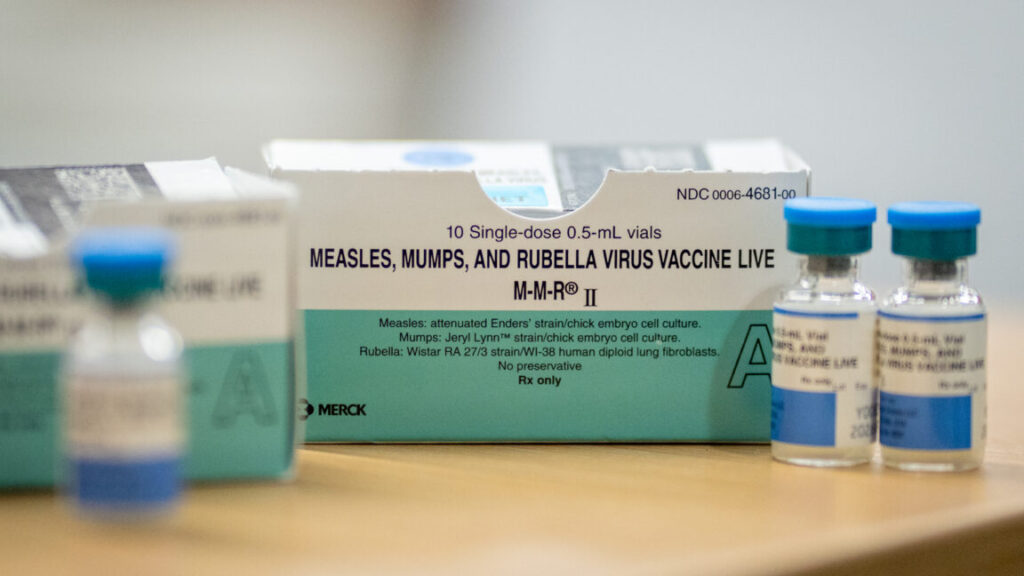Parents give kids more melatonin than ever, with unknown long-term effects
More children are taking the hormone in the form of nightly gummies or drops.
Two years ago, at a Stop & Shop in Rhode Island, the Danish neuroscientist and physician Henriette Edemann-Callesen visited an aisle stocked with sleep aids containing melatonin. She looked around in amazement. Then she took out her phone and snapped a photo to send to colleagues back home.
“It was really pretty astonishing,” she recalled recently.
In Denmark, as in many countries, the hormone melatonin is a prescription drug for treating sleep problems, mostly in adults. Doctors are supposed to prescribe it to children only if they have certain developmental disorders that make it difficult to sleep—and only after the family has tried other methods to address the problem.
But at the Rhode Island Stop & Shop, melatonin was available over the counter, as a dietary supplement, meaning it receives slightly less regulatory scrutiny, in some respects, than a package of Skittles. Many of the products were marketed for children, in colorful bottles filled with liquid drops and chewable tablets and bright gummies that look and taste like candy.
A quiet but profound shift is underway in American parenting, as more and more caregivers turn to pharmacological solutions to help children sleep. What makes that shift unusual is that it’s largely taking place outside the traditional boundaries of health care. Instead, it’s driven by the country’s sprawling dietary supplements industry, which critics have long said has little regulatory oversight—and which may get a boost from Secretary of Health and Human Services Robert F. Kennedy Jr., who is widely seen as an ally to supplement makers.
Thirty years ago, few people were giving melatonin to children, outside of a handful of controlled experiments. Even as melatonin supplements grew in popularity among adults in the late 1990s in the United States and Canada, some of those products carried strict warnings not to give them to younger people. But with time, the age floor dropped, and by the mid-2000s, news reports and academic surveys suggest some early adopters were doing just that. (Try it for ages 11-and-up only, one CNN report warned at the time.) By 2013, according to a Wall Street Journal article, a handful of companies were marketing melatonin products specifically for kids.
And today? “It’s almost like a vitamin now,” said Judith Owens, a pediatric sleep specialist at Harvard Medical School. Usage is growing, including among children who are barely out of diapers. Academic surveys suggest that as many as 1 in 5 preteens in the US now take melatonin at least occasionally, and that some younger children consume it multiple times per week.
Sleep aids, many of them melatonin, are displayed for sale in a Florida store in 2023. In the US, melatonin is available over the counter, but in many other countries the hormone is a prescription drug mostly used by adults. Credit: Joe Raedle/Getty Images
On social media, parenting influencers film themselves dancing with bottles of melatonin gummies or cut to shots of their snoozing kids. In the toxicology literature, a series of reports suggest a rise in melatonin misuse—and indicate that some caregivers are even giving doses to infants. And according to multiple studies, some brands may contain substantially higher doses of the hormone than product labels indicate.
The trend has unsettled many childhood sleep researchers. “It is a hormone that you are giving to young children. And there’s just very little research on the long-term effects of this,” said Lauren Hartstein, a childhood sleep researcher at the University of Arizona.
In a 2021 journal article, David Kennaway, a professor of physiology at the University of Adelaide in Australia, noted that melatonin can bind to receptors in the pancreas, the heart, fat tissue, and reproductive organs. (Kennaway once held a patent on a veterinary drug that uses melatonin to boost the fertility of ewes.) Distributing the hormone over the counter to American children, he has argued, is akin to a vast, uncontrolled medical experiment.
“It is a hormone that you are giving to young children. And there’s just very little research on the long-term effects of this.”
To others, that kind of language might seem alarmist—especially considering that melatonin appears to have mild side effects, and that sleep problems themselves can have consequences for both child and parental health. Many caregivers report melatonin is helpful for their children, and it’s been given for years to children with autism and ADHD, who often struggle to sleep. Beth Malow, a neurologist and sleep medicine expert at Vanderbilt University Medical Center who has consulted for a pharmaceutical company that manufactures melatonin products, raised concerns about a tendency to highlight “the evils of melatonin” without noting that “it’s actually very safe, and it can be very helpful.” Focusing just on the negatives, she added, “is to throw the baby out with the bathwater.”
All of this leaves parents navigating a lightly regulated marketplace while receiving conflicting medical advice. “We know that not getting enough sleep in early childhood has a lot of bad effects on health and attention and cognition and emotions, et cetera,” said Hartstein. Meanwhile, she added, “melatonin is safe and well-tolerated in the short term. So there’s a big question of, well, what’s worse, my kid not sleeping, or my kid taking melatonin once a week?”
As for the answer to that question, she said: “We don’t know.”
Mother’s little helper
The urge—the desperate, frantic, all-consuming urge—to get a child to fall sleep is familiar to many parents. So is the impulse to satisfy that urge through drugs. Into the early 20th century, parents sometimes administered an opiate called laudanum to help young children sleep, even though it could be fatal. Decades later, when over-the-counter antihistamines like Benadryl became popular, some parents began using them, off-label, as a sleep aid.
“Most people are pretty happy to resort to over-the-counter medication if their kids are not sleeping,” one mother of two small kids told a team of Australian researchers for a 2004 study. “It really saves the children’s lives,” she added, because “it stops mums from throwing them against the wall.”
Compared to other sleep aids, melatonin supplements have obvious advantages. Chief among them is that they mimic a natural hormone: The body secretes melatonin from a pea-sized gland nestled in the brain, typically starting in the early evening. Levels peak after midnight, and drop off a few hours before sunrise.
Artificially boosting melatonin helps many people fall sleep earlier or more easily.
“There’s a big question of, well, what’s worse, my kid not sleeping, or my kid taking melatonin once a week?”
When a child takes a 1 milligram dose of melatonin, the hormone quickly enters their bloodstream, signaling to the brain that it’s time for sleep. Melatonin reaches levels in the blood that can be more than 10 times higher than natural peak concentrations. Soon, many children begin to feel drowsy.
Children can generally tolerate melatonin. Known side effects appear to be mild, and, compared to antihistamines, people taking low doses of melatonin are less likely to wake up feeling groggy the next morning.
As early as 1991, some researchers began administering small doses of the hormone to children with autism, who sometimes have extreme difficulty falling and staying asleep. A series of trials conducted in the Netherlands in the 2000s found that melatonin could also have modest benefits for non-autistic children experiencing insomnia, and it seemed to be safe in the short-term—although the long-term consequences of regularly taking the hormone were unclear.
The timing of the research coincided with a move in the US to loosen regulations on dietary supplements, led by Sen. Orrin Hatch of Utah, a supplement-industry hub.
News reports suggest that, by the late 2000s, some parents were trying melatonin for older children.
It’s hard to know for sure who first decided to market melatonin specifically to children, but a key player seems to be Zak Zarbock, a Utah pediatrician and father of four boys who, in 2008, began selling a drug-free, honey-based cough syrup. In 2011, his company, Zarbee’s, introduced a version of its children’s cough remedy that contained melatonin. Soon after, Zarbee’s launched a line of melatonin supplements tailored to children. In a 2014 press release, Zarbock stressed that “a child shouldn’t need to take something to fall asleep every night.” But melatonin, he said, could act like “a reset button for your bedtime routine” when things got out-of-whack. (Zarbock did not respond to interview requests.)
More products followed, and usage rates have climbed. One possible reason for that is that American children are having more difficulty falling asleep. Some experts think screen use is causing sleep problems, and rising rates of anxiety and depression among children may also be affecting slumber. Clinicians report treating families that use melatonin to counteract the stimulating effects of caffeine.
Another possibility—and they’re not mutually exclusive—is that supplement makers sensed a market opportunity and seized it. Gummies have made melatonin more palatable to children; supplement makers now market widely to parents online. At least one company seems to have made overtures to parents via a pediatrics organization: Vicks ZzzQuil, a popular line of children’s melatonin products, sponsored a 2020 webinar on sleep hosted by the American Academy of Pediatrics.
How to anger sleep scientists
Is melatonin a harmless natural supplement or a sleep drug? The culture, at times, seems unsure: It’s easy to find parents fretting in online forums about whether the gummies are safe. Daycare workers have undergone criminal prosecution after providing melatonin to their charges without parental consent.
In their marketing, meanwhile, supplement companies consistently describe their melatonin products as drug-free, non-habit-forming, and safe. In one promotional video for Zarbee’s, Zarbock, wearing sky-blue scrubs, tells parents that “in recent short- and long-term studies, melatonin has been shown to be safe and effective for children.” Echoing language used across the industry, Zarbee’s melatonin gummies are marketed today as “safe and drug-free.”
Such claims raise hackles among sleep scientists. “That kind of advertising is unconscionable,” wrote Kennaway, the Adelaide professor, in an email. “Melatonin ingested whether in a gummy or a tablet is being administered as a drug,” he wrote. (In a brief statement sent by Tyra Weeks, a spokesperson, Zarbee’s noted its melatonin products are “regulated as a dietary supplement ingredient by the FDA,” adding that they “do not contain active pharmaceutical ingredients.”)
What’s behind the growing use of melatonin to help children sleep? Some experts think screen use is causing sleep problems, and rising rates of anxiety and depression among children may also be affecting slumber. Credit: Johner Images/Getty Images
Among other things, Kennaway worries that long-term melatonin use could have unintended effects, including on the developing reproductive system. While it is known that melatonin can interact with lots of tissues, not just the parts of the brain responsible for initiating sleep, many experts note that there is little long-term safety data on supplemental use of the compound.
“Don’t be fooled by thinking that somehow, this is like a vitamin. It’s a drug,” said Owens, the Harvard sleep specialist. “It’s a medication. And there are no really long-term studies that have looked at things like impact on pubertal development.” (Jess Shatkin, a child psychiatrist at New York University’s medical school, noted that such gaps are common even for marquee prescription medications: “I don’t know of a safety study of Zoloft that goes more than two years,” he said, by way of an example.)
Owens has been in clinical practice for 35 years. The arrival of melatonin, she said, felt abrupt: Around 10 years ago, it suddenly seemed that every patient in her clinic was taking it. She is concerned now about inappropriate use, including caregivers using the hormone for children who do not have insomnia; she has heard reports of a summer camp nurse handing it out to campers at bedtime.
“One of the things that disturbs me the most is when I hear a parent say, ‘Oh well, she asks for her melatonin every night and she says she can’t sleep without it,’” Owens said. “You’re setting up a potential lifetime of dependence on sleeping medication.” (Owens has testified in a lawsuit against Zarbee’s, and she consults for AGB-Pharma, a Swedish firm that makes a prescription melatonin drug.)
Is melatonin a harmless natural supplement or a sleep drug? The culture, at times, seems unsure.
Owens and other researchers say melatonin can be helpful for children with neurodevelopmental disorders like autism and ADHD, who may otherwise be unable to establish a stable sleep routine. And they say it may be useful for other children who struggle to sleep—with certain safeguards.
Recently, teams of researchers in Europe and the United States have evaluated what melatonin can do. Edemann-Callesen, the Danish researcher, works at the Centre for Evidence-Based Psychiatry. She recently led a team to systematically collect and review published studies of melatonin in children. The evidence, she said, was mixed. Studies suggest that melatonin can help children fall asleep around 15 or 20 minutes earlier, on average. Whether that translates to a more rested kid is less clear: “When you look at the evidence,” she said, “melatonin doesn’t affect daytime functioning.”
Overall, she said, there just isn’t much research out there to draw on.
In both the US and Europe, experts are converging on certain recommendations: Families should consult a health care provider before use. They should try simple, non-pharmacological steps to improve sleep first, and only turn to melatonin if that fails. They should start with a low dose—typically around 0.5 mg. And they should only use melatonin for a few weeks as a kind of crutch, ideally dosing the hormone to help establish a better sleep routine and then weaning the child off the supplement.
Some families have been scared off by alarming reports about melatonin. Malow, the Vanderbilt sleep expert, began studying melatonin in the 2000s, as a sleep aid for children with autism. Recently, she said, some families who rely on the supplement to help their children have gotten jumpy: “I had a lot of families tell me in clinic, ‘I’m really worried about melatonin. I read this, I read that, is it safe?” She makes sure they’re using a brand that submits its products to external certification. “And I’d be like, you know, it’s working. It’s working for your kid. Why stop it?”
In 2021, Malow and several colleagues published a study of melatonin safety, looking at 80 children and adolescents who had taken the hormone over the course of two years. They did not flag any serious side effects, and the children’s puberty seemed to progress normally. (The study was funded by Neurim Pharmaceuticals, which manufactures a melatonin drug prescribed outside the US.)
Malow acknowledged the study was small, but she said the findings aligned with her own years of clinical experience. “At least it’s something,” she said. “And I have not, in my experience, had any kids where I was concerned, or the parents were concerned, that puberty was delayed because of melatonin use.”
Consult with your family doctor
Last year, the Council for Responsible Nutrition, a leading supplement industry group, published voluntary guidelines for its members. Among them: put products in child deterrent packaging; tell people to consult a pediatrician before using melatonin; and warn caregivers that melatonin is “for occasional and/or intermittent use only.”
Plenty of manufacturers aren’t part of CRN, and it’s not hard to find suppliers that aren’t in compliance with those recommendations. And whether parents follow the recommendations is something else entirely. User reviews and academic surveys indicate that some parents are dosing regularly for months or years on end, and the products themselves seem packaged for long-term use: For example, the company MaryRuth’s sells bottles of children’s melatonin gummies labeled “2 month supply.” Natrol, a popular brand that warns caregivers that the product is “for occasional short-term use only,” sells bottles containing 140 doses. (MaryRuth’s did not respond to requests for comment, and a spokesperson for Natrol declined to comment.)
Meanwhile, as melatonin sales climb, a growing body of evidence points to cases of misuse.
One issue: Children seem to be sometimes finding, and swallowing, gummies and other melatonin products. Calls to poison control centers for pediatric melatonin ingestion increased 530 percent between 2012 and 2021, according to one analysis published by the US Centers for Disease Control and Prevention.
Mostly, nothing happened: Among small children, the large majority of the incidents were resolved without the child experiencing symptoms at all. When symptoms do appear, they tend to be mild—drowsiness, for example, or gastrointestinal upset. (Achieving a lethal dose of melatonin appears to be virtually impossible, said Laura Labay, a forensic toxicologist at NMS Labs, which provides toxicology testing services.)
Still, some experts have expressed concern that melatonin misuse might, in rare cases, contribute to more serious outcomes.
In 2015, Sandra Bishop-Freeman, now the chief toxicologist at the North Carolina Office of the Chief Medical Examiner, was called to review on a tragic case. A 3-month-old girl had died in her crib. More than 20 bottles of melatonin were found in the home, and an investigation showed that the girl and her twin sister had been given 5 milligram doses of melatonin multiple times per day to help them sleep. The infant’s blood levels of melatonin were orders of magnitude above the natural range.
“Oftentimes when I explore topics, it’s because we find things that were previously unknown or confusing to us,” Bishop-Freeman told Undark. She wasn’t sure if melatonin had contributed to the infant’s death. But as she read more about the hormone, she felt concerns, especially when her office received several more cases involving elevated levels of melatonin. “It was hard to just tell the pathologist, ‘Eh, no worries, everyone thinks it’s safe, so you’re fine,’” she said.
User reviews and academic surveys indicate that some parents are dosing regularly for months or years on end, and the products themselves seem packaged for long-term use.
In 2022, Bishop-Freeman and colleagues published a paper detailing seven cases of undetermined pediatric deaths where bloodwork revealed elevated levels of melatonin. (They’ve seen more since finishing the paper.) “We don’t want to overstate these findings,” she said: The causes of the deaths are unknown, and the presence of melatonin may just be a coincidence. But her team can’t rule out the hormone as a possible contributor, she said, and investigators should be alert to elevated melatonin levels, which may sometimes be overlooked.
Labay, the forensic toxicologist, said she found those concerns plausible. But, she added, “I think I’m still waiting for the paper that says, ‘This was a pure melatonin death and there was no other contributing cause to that death.'”
Melatonin gummies have made the drug more palatable to children, and supplement makers now market them widely to parents online. But data suggests that the widespread availability of the supplements, often resembling candy, can lead to misuse. Credit: Joe Raedle/Getty Images
As more children take melatonin, some experts want the supplement industry to do more to prevent them from taking too-large quantities. Pieter Cohen, an internist and a prominent critic of supplement industry practices, faulted regulators for not requiring childproof caps and questioned why companies sell what he describes as higher-than-necessary doses of the hormone.
Many products also have considerably more melatonin than is listed on the label. Last year, a US Food and Drug Administration team analyzed melatonin content in 110 products that appeared in online searches for things like “melatonin + child,” and found dozens of mismatches. In one case, a product contained more than six times the amount on the label.
The study was submitted to a journal in July 2024. So far, the agency has not taken any public action against those companies. “The FDA is not doing their job. They’re basically cowering to the industry,” Cohen said.
In a statement from the FDA, sent by spokesperson Lindsay Haake, the agency said that the products analyzed in the study were “individually evaluated to determine if any agency follow up was needed.” The statement added that “we do not discuss potential or ongoing compliance or enforcement matters with third parties.”
“The FDA is not doing their job. They’re basically cowering to the industry.”
Steve Mister, the president and CEO of the Council for Responsible Nutrition, said manufacturers often have to sell products with higher levels in order to make sure there’s melatonin available throughout a product’s shelf-life. Those so-called overages, he stressed, are modest and safe: “Whatever we put in, we still have confidence that it is safe on day one,” he said.
The supplement industry, Mister said, has taken steps to ensure that melatonin is used responsibly, including the guidelines his organization issued last year. “I think our voluntary program is an illustration that we want to step up and do some education of parents,” he said.
He pushed back against suggestions that the supplement industry was not a responsible steward of melatonin, or that it was unwise for the hormone to be sold as an over-the-counter supplement: “Look at the safety and look at the number of doses that are sold in this country every year, and how few adverse events there are, and how little evidence that there is a concern,” Mister said. Other countries, he added, may choose to limit melatonin to prescription-use only. “They like the way their system is set up. That doesn’t mean that it’s right for the US.”
Bedtime struggles take a toll on everyone
For parents whose children struggle to fall sleep, the costs of an interminable bedtime can feel high: exhausted children, burned-out parents, and family conflict that stretches into the night. In online videos and forums, parents disclose insecurity (“We are now at the stage in parenthood where we drug our kids,” one mother says in a TikTok) and gratitude (“It’s saved our sanity,” writes a parent on Reddit). Caregivers talk about their children getting better rest—but it can seem as if the supplement is as much for parents’ mental health as it is for children’s restful sleep.
From the vantage point of a chaotic bedtime, the safety concerns about melatonin can feel academic, privileging unknown or speculative harms (such as the possibility of long-term side effects) over the chance of immediate relief. In conversations, physicians and psychologists who devote their careers to children’s sleep stress the importance of a good night’s rest. But some worry melatonin is often used as a shortcut—and suggest there are more effective paths to improved sleep that families could take, especially if they had better support.
For parents whose children struggle to fall sleep, the costs of an interminable bedtime can feel high: exhausted children, burned-out parents, and family conflict that stretches into the night.
Candice Alfano, a professor of psychology at the University of Houston, runs a center devoted to studying childhood sleep and anxiety. In 2020 and 2021, she and her team conducted a survey of sleep health among children in foster care, who struggle with insomnia at far higher rates than the general population. Pharmacological treatments, they found, were widespread: More than one in 10 foster parents reported receiving a prescription medicine to help the children sleep. And close to half were using melatonin at least occasionally—and often regularly—to help the children sleep.
Alfano’s team has recently developed a sleep treatment program for foster families that, she said, may offer an alternative intervention to drugs and supplements. The initial findings, from a small pilot, suggest it’s effective.
The appeal of melatonin, though, remains, both for caregivers and for the pediatricians who advise them, Alfano said: “It’s seemingly a quick and easy suggestion: ‘You know, here’s something you could go get over the counter. You don’t even need a prescription from me.’”
But the goal, she said, is something else: “to teach these children how to sleep, rather than just sleep.”
This article was originally published on Undark. Read the original article.
Parents give kids more melatonin than ever, with unknown long-term effects Read More »

